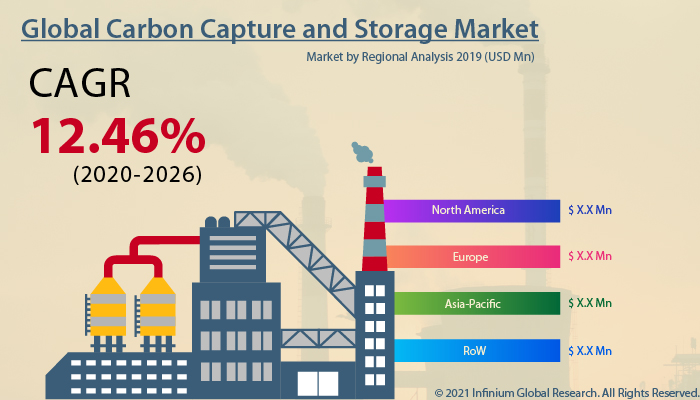Carbon Capture and Storage Market (Technology - Pre-combustion, Post Combustion, and Oxy-fuel Combustion; Application - Oil and Gas, Chemical Processing, Power Generation, and Others): Global Industry Analysis, Trends, Size, Share and Forecasts to 2026
A recent report published by
Infinium Global Research on carbon capture and storage market provides in-depth
analysis of segments and sub-segments in the global as well as regional carbon
capture and storage market. The study also highlights the impact of drivers,
restraints, and macro indicators on the global and regional carbon capture and
storage market over the short term as well as long term. The report is a
comprehensive presentation of trends, forecast and dollar values of the global
carbon capture and storage market. According to the report, the global carbon
capture and storage market is projected to grow at a CAGR of 12.46% over the
forecast period of 2020-2026.

Market Insight
The global carbon capture and storage market was valued at USD 2,597 million in 2020 and is projected to reach near USD 5,254 million
by 2026, growing at a CAGR of 12.46% from 2020 to 2026. Carbon capture and
storage is a technology that captures around 90% of CO2 produced from numerous
industrial operations on account of the usage of fossil fuels. This technology
primarily comprises capture, transport, and CO2 safe storage across depleted
hydrocarbon fields and deep saline aquifer formations. Furthermore, these tools
separate the generated gas through pre-combustion capture, post-combustion
capture, and oxy-fuel combustion. The captured CO2 is compacted into the liquid
state and transported to the desired storage site. The transportation is
predominantly carried out by high-capacity pipelines, ships, and road tankers
to numerous drilling locations. It is then pumped in the underground depleted
oil and gas reservoirs, coalbeds, and deep saline aquifers to increase their
ongoing production. Increasing energy demands along with soaring investment
toward the upstream & downstream sectors will further enhance the carbon
capture and storage market.
The rise in the number of
industrial projects and oil field recovery projects are the major growth
drivers identified in the carbon capture and storage market. With the rapid
development of the economy, there has been high growth in infrastructure
projects which emit carbon dioxide. Furthermore, the improved oilfield recovery
projects emit carbon dioxide when the equipment is in process. These emitted
carbon dioxide needs to be stored, thus pouring the carbon capture and storage
market growth. However, a high initial cost which is required in implementing
the carbon storage technologies may hamper the growth of the carbon capture and
storage market. On the other hand, the emerging demand for carbon dioxide
injection in EOR is an opportunity for the carbon capture and storage market.
The global COVID-19 outbreak has emerged to be the most significant health
problem, stopping nearly all the operations across industries. The novel
coronavirus infection has obstructed almost all the economies and is imposing
numerous countries to go under lockdowns to control the spread of the outbreak.
While this problem is likely to be resolved within a very short time, climate
degradation is something that requires to be tackled in the longer-term with
severe actions. Nevertheless, the main problem that is faced by industry
professionals is the requirement of large capital expenditures (CAPEX) to set
up new carbon capture plants. Furthermore, the halting of operations and
slowdown in economies with minor international trade has resulted in a
liquidity deficit among players. However, the financial booster plans
introduced by numerous administrations to support the economic revitalization,
along with a positive outlook towards industrial decarbonization will complement
the stability in the carbon capture and storage market.
Among the geographies, the North
America region is expected to hold the largest share in the global carbon
capture and storage market. The stringent regulatory framework for a cleaner
environment together with the growing need for carbon dioxide in enhanced oil
recovery processes due to the increasing number of matured oilfields is
projected to be the major factors driving the industry penetration. However,
the Asia Pacific region is expected to witness high growth in the global carbon
capture and storage market during the forecast period. The presence of numerous
large-scale projects in early development and feasibility study stages across
countries such as Australia and China is anticipated to surge the industry size
in the Asia Pacific region.
Segment Covered
The report on global carbon
capture and storage market covers segments such as technology, and application.
On the basis of technology, the sub-markets include pre-combustion, post
combustion, and oxy-fuel combustion. On the basis of application, the
sub-markets include oil and gas, chemical processing, power generation, and
others.
Companies Profiled:
The report provides profiles of
the companies in the market such as Exxon Mobil, General Electric, Halliburton,
Schlumberger Limited, Siemens, NRG Energy, Inc., Shell Cansolv, Dakota
Gasification Company, Japan CCS Co., Ltd., and Mitsubishi Heavy Industries, Ltd.
Report Highlights:
The report provides deep insights
into the demand forecasts, market trends, and micro and macro indicators. In
addition, this report provides insights into the factors that are driving and
restraining the growth in this market. Moreover, The IGR-Growth Matrix analysis
given in the report brings an insight into the investment areas that existing
or new market players can consider. The report provides insights into the
market using analytical tools such as Porter's five forces analysis and DRO
analysis of the carbon capture and storage market. Moreover, the study highlights
current market trends and provides forecast from 2020-2026. We also have
highlighted future trends in the market that will affect the demand during the
forecast period. Moreover, the competitive analysis given in each regional
market brings an insight into the market share of the leading players.
Please Choose One of them.